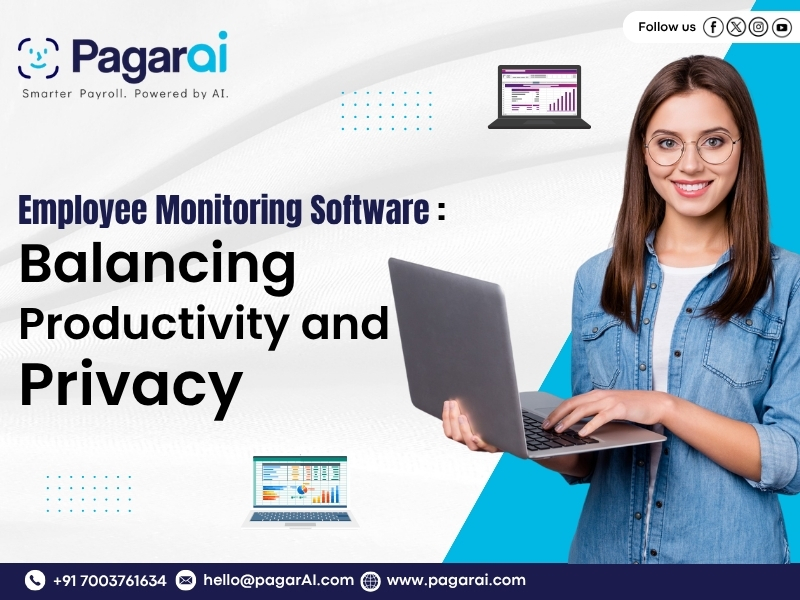Introduction: The New Era of Employee Monitoring
In the past, employee monitoring meant walking around the office to check on work. Today, teams are remote, hybrid, or spread across multiple locations — making employee monitoring software essential.
The challenge? Boosting productivity without crossing privacy lines.
When done right, monitoring tools help businesses protect company data, improve performance, and optimize workflows. When done wrong, they create distrust.
The key is to balance productivity tracking with employee rights — and AI can make this possible.
What is Employee Monitoring Software?
Employee monitoring software is a tool that tracks and records employee activities to help businesses:
- Measure productivity
- Ensure compliance
- Protect sensitive data
- Optimize resource allocation
Modern solutions go beyond just logging hours — they integrate with AI-powered productivity trackers, face recognition attendance systems, and employee tracking applications to create a complete workforce management ecosystem.
How Employee Monitoring Software Works
1. Activity Tracking
Monitors apps, websites, and tasks used during work hours.
2. Attendance Integration
Links with employee attendance management systems to verify work hours.
3. Productivity Analysis
AI determines active vs. idle time, detects workflow inefficiencies, and suggests improvements.
4. Security Alerts
Flags unusual activities that could indicate data breaches or policy violations.
Benefits of Employee Monitoring Software
1. Boosts Productivity
By showing where time is spent, it helps employees focus on high-priority tasks.
2. Enhances Security
Monitors data transfers, file access, and potential security threats.
3. Supports Remote Work
Ensures fair evaluation for remote and hybrid teams.
4. Streamlines Payroll
When linked with face attendance machines and time tracking tools, payroll becomes automatic.
5. Data-Driven Management
Managers can make informed decisions based on actual performance metrics.
Privacy Concerns & How to Address Them
Monitoring can create concerns about surveillance. To balance productivity and privacy:
- Be Transparent: Inform employees about what’s monitored and why.
- Limit Data Collection: Track only what’s necessary for performance and security.
- Follow Legal Guidelines: Comply with GDPR, HIPAA, and local labor laws.
- Allow Employee Access: Let employees view their own monitoring data.
Integration with AI for Smarter Monitoring
When paired with AI-powered productivity trackers, monitoring software can:
- Predict burnout
- Suggest workflow adjustments
- Automate attendance via AI face attendance
- Sync with employee tracking apps for location-based performance insights
Industries That Benefit Most from Monitoring Software
- IT & Software Development – Secure code repositories and track billable hours
- Finance & Banking – Compliance and fraud prevention
- Healthcare – Protect patient data while tracking workflows
- Retail & Logistics – Monitor large, distributed teams
- Remote Agencies – Track deliverables across global teams
Best Practices for Implementing Employee Monitoring Software
1. Define Objectives Clearly
Know whether you want to measure productivity, improve security, or both.
2. Get Employee Buy-In
Present monitoring as a tool for mutual benefit.
3. Choose the Right Features
Avoid overly invasive tools; focus on activity tracking, not personal surveillance.
4. Review & Optimize
Analyze reports and adapt monitoring strategies over time.
The Future of Employee Monitoring
Tomorrow’s monitoring tools will be more predictive, less intrusive. Expect:
- AI detecting workflow stress before burnout occurs
- Voice and sentiment analysis to gauge team morale
- Complete automation of attendance, payroll, and productivity reports
Conclusion: Productivity with Respect
Employee monitoring software isn’t about spying — it’s about empowering businesses to work smarter.
When integrated with AI-powered productivity trackers, face recognition attendance systems, and employee attendance management systems, it gives managers the insight they need to boost efficiency while respecting employee privacy.


